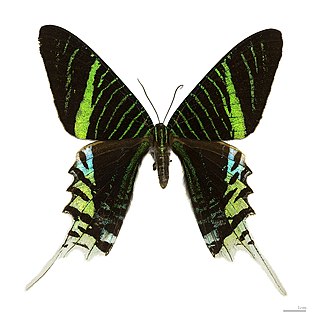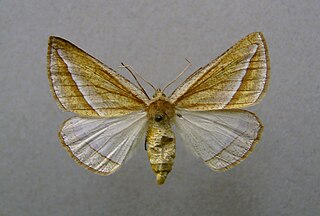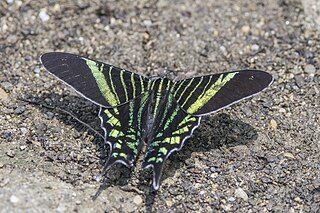
The Noctuidae, commonly known as owlet moths, cutworms or armyworms, are a family of moths. They are considered the most controversial family in the superfamily Noctuoidea because many of the clades are constantly changing, along with the other families of the Noctuoidea. It was considered the largest family in Lepidoptera for a long time, but after regrouping Lymantriinae, Catocalinae and Calpinae within the family Erebidae, the latter holds this title now. Currently, Noctuidae is the second largest family in Noctuoidea, with about 1,089 genera and 11,772 species. This classification is still contingent, as more changes continue to appear between Noctuidae and Erebidae.

The Uraniidae are a family of moths containing four subfamilies, 90 genera, and roughly 700 species. The family is distributed throughout the tropics of the Americas, Africa and Indo-Australia. Some of the tropical species are known for their bright, butterfly-like colors and are called sunset moths. Such moths are apparently toxic and the bright colors are a warning to predators.

Alexander Eduard Friedrich Eversmann was a Prussian biologist and explorer.

The Epipleminae or epiplemiine moths are a subfamily of the lepidopteran family Uraniidae. The subfamily was first described by George Hampson in 1892. They are the most diverse and widespread uraniid group, occurring mainly throughout the Pantropics but barely reaching into the temperate regions. The Epipleminae are notable for the sexually dimorphic tympanal organ which is unlike any other lepidopteran's in details of its morphology. Some species are also peculiar in being able to roll their wings into a stick-like shape, possibly as a form of crypsis. Such behavior has hitherto only been found in this subfamily and the quite unrelated Ennominae.

Arctia menetriesii, the Menetries' tiger moth, is a species of tiger moth in the family Erebidae. It was first described by Eduard Friedrich Eversmann in 1846. It is found in Karelia, Oktyabrskoe, northeastern Kazakhstan, Altai Mountains, Sayan Mountains, Evenkia, Yakutia, the central Amur region, Primorsky Krai and central Sakhalin. It was believed to be extinct in Fennoscandia, but the species has been recently recorded in Finland. This species is characterized by the fact that they never come to light; such behavior is atypical in the family Arctiidae.

Lyssa zampa, the tropical swallowtail moth or Laos brown butterfly, is a moth of the family Uraniidae. The species was first described by British entomologist Arthur Gardiner Butler in 1869.

Sclerocona is a genus of moths of the family Crambidae which contains only one species, Sclerocona acutella. It was first described by the Prussian biologist Eduard Friedrich Eversmann in 1842.

Chariaspilates is a monotypic moth genus in the family Geometridae erected by Eugen Wehrli in 1953. Its only species, Chariaspilates formosaria, was first described by Eduard Friedrich Eversmann in 1837. It is found in swampy areas from Europe to Japan.

Urania leilus, the green-banded urania, is a day-flying moth of the family Uraniidae. The species was first described by Carl Linnaeus in his 1758 10th edition of Systema Naturae. It is found in tropical South America east of the Andes, especially in the Amazon rainforest. Its range includes Suriname, Guyana, French Guiana, eastern Colombia, Venezuela, eastern Ecuador, Brazil, northern Bolivia, eastern Peru, as well as the island of Trinidad. It has been recorded as a vagrant to the central and northern Lesser Antilles, such as St. Kitts, Barbados and Dominica. Their preferred habitat consists of riverbanks, in primary and secondary rainforest, at elevations between sea level and about 800 m (2,600 ft).

Urania fulgens, the urania swallowtail moth or green page moth, is a day-flying moth of the family Uraniidae. The species was first described by Francis Walker in 1854. It is found from Veracruz, Mexico, through Central America to northwestern South America. It is highly migratory and has been recorded as a vagrant to the US state of Texas.

Epiplema is a genus of moths in the family Uraniidae described by Gottlieb August Wilhelm Herrich-Schäffer in 1855. A number of species have been reassigned to Europlema.

Dyspessa is a genus of moths belonging to the family Cossidae. It was described by Jacob Hübner in 1820.

Dyspessa salicicola is a species of moth of the family Cossidae. It was described by Eduard Friedrich Eversmann in 1848. It is found in Greece, North Macedonia, Bulgaria, Romania, Ukraine, Russia and Turkey.
William Warren was an English entomologist who specialised in Lepidoptera.

Urania boisduvalii is a day-flying moth of the family Uraniidae. It was first described by Félix Édouard Guérin-Méneville in 1829. A genetic analysis of Urania moths gave rise to a phylogenetic tree which places U. boisduvalii as sister to the in-group that includes U. fulgens spp. poeyi, U. fulgens, U. sloanus, U. sloanus, U. leilus and U. leilus spp. brasiliensis.

Arocatus melanocephalus, the elm seed bug, is a true bug in the family Lygaeidae. The species was initially described by Johan Christian Fabricius in 1798, and Maximilian Spinola designated it to be the type species of the genus Arocatus in 1837. This bug is native to Europe but has been introduced to North America.
Eversmannia is a genus of moths, belonging to the family Uraniidae.
Apamea ferrago is a moth belonging to the family Noctuidae. The species was first described by Eduard Friedrich Eversmann in 1837.















